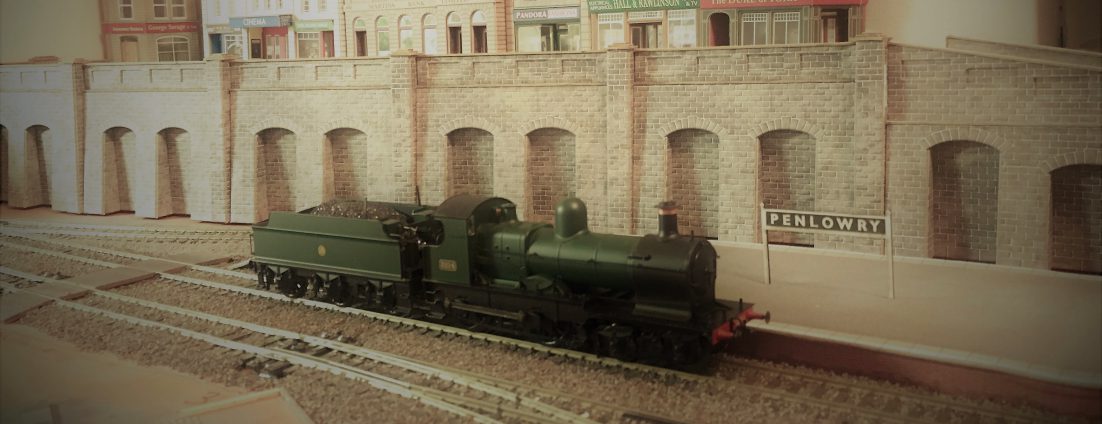For those of you with a pedigree of railways and railway films, the quote above will be all too familiar. The Titfield Thunderbolt’s inspection run crewed by the dog collar brigade, grey shirt at the controls, purple shirt firing.
As you may have noticed from my earlier posts I do like an oddity or a might have been. One day I would like to produce the Titfield Thunderbolt set but the title of this post is actually because I want to discuss a might have been linked to bishops – the Great Western Cathedrals.
Despite being born, brought up, and living in Yorkshire I do like the Great Western. The influence for that is my father who was born and brought up in Gloucester so was innundated with GW and LMS designs. His Uncle was signalman at Yeovil Junction so he saw a fair bit of Southern action too but the only LNER types he saw were the odd BXX classes occasionally coming through on CrossCountry workings. So our model railway at home when I was growing up was GW mainline with a station on the beach (complete with mermaid).
The Great Western did things first and generally rather well (up until the 1930s, and had it not been for the war they probably would have been the first to electrify a mainline. Unfortunately in the 1930s and 40s they trod water and lost ground).
The Cathedral class was Hawksworth’s Pacific design which he produced in 1946. Unfortunately post war economies and impending nationalisation meant it never emerged although looking at the GA you would be forgiven to think he’d nicked the design from a certain Mr Stanier FRS (which given they were contemporaries at Swindon it is highly likely Stanier used his position to develop the ideas he and Hawksworth had developed together). There is no definitive record that the class would have been called after cathedrals but various modellers who have produced them have taken this suggestion and made it reality (Actually the Kings were supposed to have been Cathedrals but if you’re going to send your new loco to the US why not remind them they’re not part of the Commonwealth?!).
Modelling a Cathedral is relatively straightforward. The recipe is below and in the pictures linked.
Ingredients:
1x Hornby Princess Royal
1x Hornby King body and front bogie
1x Hawksworth tender (Dapol or Hornby)
1x Princess dome
1x King smokebox door
1x pair of King buffers
Various pieces of plasticard
Method:
Replace dome with safety valve bonnet from the King. Add new dome further up the boiler (note this isn’t as per the original drawing but most modellers prefer the idea of keeping a bonnet). Replace chimney with GW double chimney from King. Replace cab and backhead with GW one from King. Replace front bogie with the one from King. Replace smokebox door with a King one (either the one off the King or buy a new Hornby spares one). Move reverser rod from LHS to RHS. Replace slidebars and cylinders with ones from King, Add buffers. Make fire-iron tunnel on RHS footpate. Replace whistles with GW ones from King. Remove outside Walchearts valve gear. Sell LMS tender on eBay. Add Hawksworth tender.
Various people have tried this and two known examples are Roger Meadows No. 8000 Gloucester Cathedral, and Nick Parson’s No. 8001 Exeter Cathedral. They have some detail differences but the main build is the same. There is also something of a step by step guide on the RM Web here.
I like a good story (you may have noticed). With this in mind I thought it might be worth sorting out the fleet list given two of them already exist (and there is already confusion over what name 8001 carries). So here is my suggestion. The first batch of 5 was built and given West Country Cathedral names. The second batch of 5 was built following the success of the first batch and given West Midlands route Cathedral names. The final batch of 10 were named after the Welsh Cathedrals, which left four to be named after other notable English Cathedrals.
| 8000 | Gloucester Cathedral |
| 8001 | Exeter Cathedral |
| 8002 | Bristol Cathedral |
| 8003 | Truro Cathedral |
| 8004 | Wells Cathedral |
| 8005 | Birmingham Cathedral |
| 8006 | Chester Cathedral |
| 8007 | Hereford Cathedral |
| 8008 | Oxford Cathedral |
| 8009 | Worcester Cathedral |
| 8010 | Bangor Cathedral |
| 8011 | Brecon Cathedral |
| 8012 | Llandaff Cathedral |
| 8013 | Newport Cathedral |
| 8014 | St Asaph Cathedral |
| 8015 | St David’s Cathedral |
| 8016 | Canterbury Cathedral |
| 8017 | Southwark Cathedral |
| 8018 | St Paul’s Cathedral |
| 8019 | York Minster |
So yes, one day I will build one. And yes, I’m a Yorkshireman, so it’ll be 8019. Apart from anything else, a Cathedral class locomotive not called Something “Cathedral” is an oddity in an oddity.





02/08/2014 at 19:42
Reblogged this on Loco Yard and commented:
Looks like an interesting project!
Pingback: Pacific planning | Penlowry